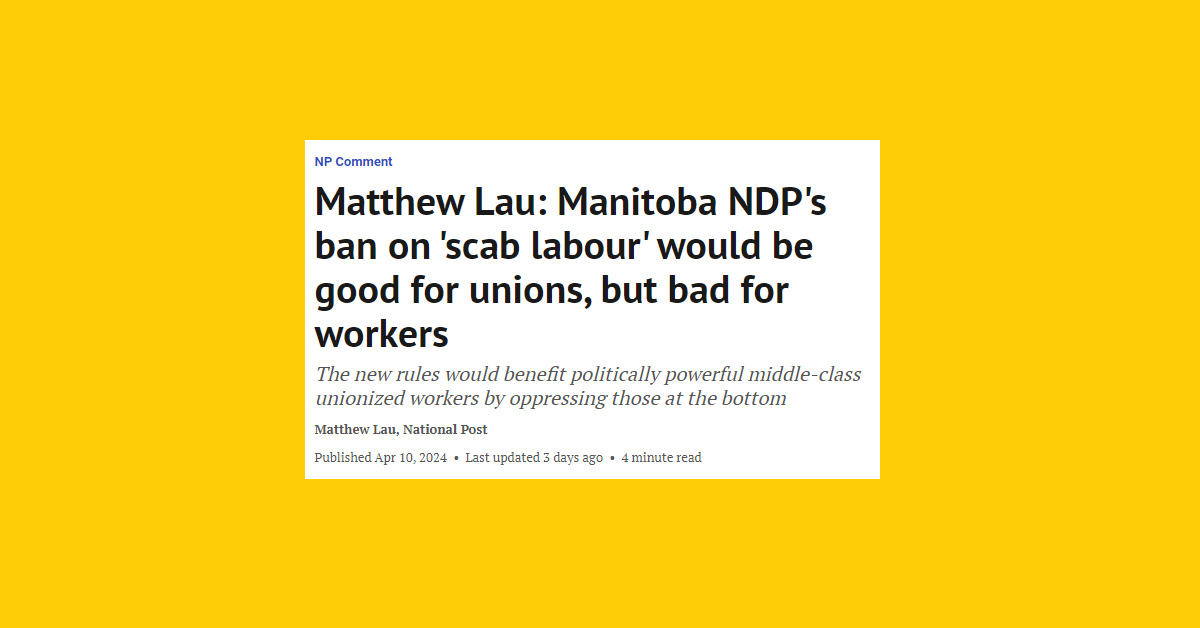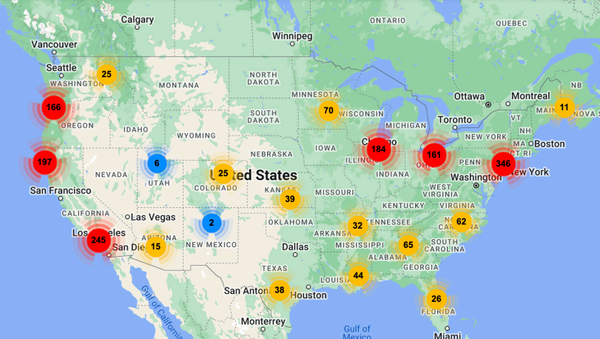
Canadian employers and their organizations are out in force to oppose pending bans on replacement workers in some jurisdictions. Last week, the National Post joined the fray and published an article attacking the Manitoba NDP government’s proposed anti-scab legislation.
Of course, it’s no shock to find anti-unionism in the National Post. However, the article by Matthew Lau — an “adjunct scholar” at the right-wing Fraser Institute — is cartoonishly bad, even by the standards of the genre.
Before writing this response, I contacted the editor of the comment section at the National Post to raise an issue with Lau’s article. He told me “the piece stands as is.” I don’t think it should.
In Lau’s telling, anti-scab legislation is bad for workers because these sorts of laws “benefit politically powerful middle-class unionized workers by oppressing those at the bottom.”
Generally, I have more respect for those who oppose labour-friendly legislation because it’s against their class interests. At least they’re honest about it.
Instead, Lau expresses concern for under-privileged workers, supposedly crushed by the weight of big labour and even bigger government, writing, “[U]nions have lots of political power and privilege, while potential replacement workers have none. And the unions wield this power via union-friendly governments, like the Manitoba NDP, to oppress less privileged workers.”
Lau takes particular offence to praise from the Canadian Labour Congress of the Manitoba NDP’s push to ban scabs. He notes what he describes as a “curious line” from CLC president Bea Bruske’s statement: “Workers everywhere should be able to exercise their right to strike without worrying about the threat of scab labour.” But aren’t scabs workers too, Lau laments.
What Lau is doing is repurposing anti-union talking points to appear pro-worker. You might call this ‘punching down while appearing to punch up.’ It’s not the least bit original either, as it’s long been a standard feature of the right-wing playbook: standing up for the ‘little guy’ against the ‘union bosses.’
Lau further writes, “when they [the CLC] say ‘should be able to exercise their right to strike without worrying about the threat of scab labour,’ they mean unionized workers everywhere should be able to go on strike without worrying about competition from other people who might want jobs, as those other people will be banned from competing for those jobs by the government.”
In the worldview of the anti-labour right, workers should embrace competition, not solidarity. Somehow a race to the bottom will raise wages. If only unions would get out of workers’ way.
Much to Lau’s consternation, workers in Manitoba will soon also be able to form or join unions through card-check again. Card-check certification was the standard in the province until the previous Conservative government revoked it in 2016. Putting card-check back in place will likely increase successful union certifications, as it’s intended.
This too is bad for workers, according to Lau. Regurgitating the standard employer talking point, he claims that “secret ballot” union elections are more democratic because they allow workers to freely exercise choice without “intimidation by union organizers.”
There is a mountain of evidence demonstrating how frequently employers violate workers’ right to organize. Anyone who has ever been involved in an organizing drive has such stories. It takes a special kind of ideologue to think that union organizers are the ones doing the intimidating.
Instead of examining this evidence, Lau mobilizes scholarship on unionization to fit his narrative in a troubling way. By quoting the conclusions of several studies without explaining their arguments, he is able to claim that union organizing and progressive labour-policy are actually bad for workers.
For example, Lau cites the conclusion of a 2022 study by two MIT economists to argue that unionization “decreases an establishment’s employment and likelihood of survival.”
While the authors did report this as a finding, Lau fails to explain why. The firm closures reported in the study were driven by employer opposition to unionization. Recalcitrant employers preferred to close their firms or shift production elsewhere rather than collectively bargaining with their workers.
The point is evidenced by comparing the service and production sectors. The study’s authors write: “In the service sector, where most recent union organizing has occurred, we find small and sometimes insignificant effects of unionization. Alternatively, the overall employment and survival declines are driven by elections in manufacturing and the other [industrial sector] industries.”
Put another way, in sectors where capital was less mobile because firms needed to sell or provide services in specific locations, closures and relocations were less common. Industrial production was more susceptible to union-busting through plant closures because production could often be moved. This has been a standard feature of the neoliberal economy of the past several decades, as Kate Bronfrenbrenner, one the most highly respected American labour studies scholars, has meticulously documented.
This is a failure of policy, not of unionization. That the law allows employers to disregard the democratic decision of their workers to organize is hardly the fault of unions.
As the MIT authors Lau cites summarize, “The standard economic explanation for why establishments close after unionization is that unions make establishments unprofitable by increasing wages or implementing other workplace changes. However, this explanation is not supported by existing research.”
Lau also cites a more technical study, from the Journal of Labor Economics, as evidence that unions reduce pay and employment. This article does indeed find that, at the enterprise level, unionization tends to reduce employer payroll in the dataset under consideration. But not for the reasons Lau seems to imply.
In the words of the study’s authors: “These effects [payroll decreases] are driven not by wage cuts for given workers but by the effect of unionization on what kinds of workers end up employed at unionizing establishments: older and higher-paid workers are more likely to leave following union certification, while younger workers are more likely to join or stay. Earnings of workers who stay employed at the establishment before and after union certification are little affected on average.”
Plainly, this is what’s referred to as a “composition effect.” Unions aren’t causing particular workers’ wages to fall, obviously. Rather, the types of workers at newly unionized firms (those under consideration in this U.S. study) are changing.
Next, Lau brings up another study to suggest that bans on replacement workers, like all labour-friendly legislation, actually reduce wages and investment and so harm workers.
In this case, the study in question did find that bans on replacement workers marginally reduce wage settlements. However, the explanations offered by the authors don’t fit neatly into the simplistic narrative pushed in Lau’s article.
“One plausible explanation for our negative result on wages for bans on replacement workers,” the study’s authors write, “might be reduced investment or a relocation of investment. Some earlier studies have found that labor-relations legislation and employment regulation decrease foreign direct investment.”
Again, the study found that employers oppose unions and labour-friendly policy whenever and wherever they can.
Such employer opposition to unions has characterized many developed capitalist economies for the past several decades. Unfortunately, most governments have either encouraged it or stood idly by. Now, as interest in unionization has grown and workers are pressing governments to implement labour-friendly reforms, writers like Lau want to suggest that collective bargaining is against workers’ interests.
In this sense, Lau’s article is a variation on a long-standing right-wing argument against unions and progressive social policy.
Any intervention into the workings of the magical ‘free market’ will inevitably generate negative outcomes. Trying to organize against low-wage work? Don’t, the employer will just close. Trying to give union members greater power over their jobs by banning replacement workers? You’ll only harm investment and employment.
Workers and unions have contended with these arguments for as long as capitalism has been around. The right-wing commentariat periodically deploys them to discourage workers from standing up for themselves. Yet, as Karl Polanyi argued, capitalism continues to generate its “double movement”: those harmed by the free markets celebrated by the right organize and fight back.
Recent Class Struggle Issues
- April 8 | Pay Transparency Is A Collective Win For Workers
- March 25 | The U.S. Is Witnessing A Considerable Growth In Strike Activity
- March 18 | Card-Check Union Certification In B.C. Has Been A Major Success
- March 11 | Doug Ford’s Failed Wage Restraint Measure Has Cost Ontario Billions








Member discussion